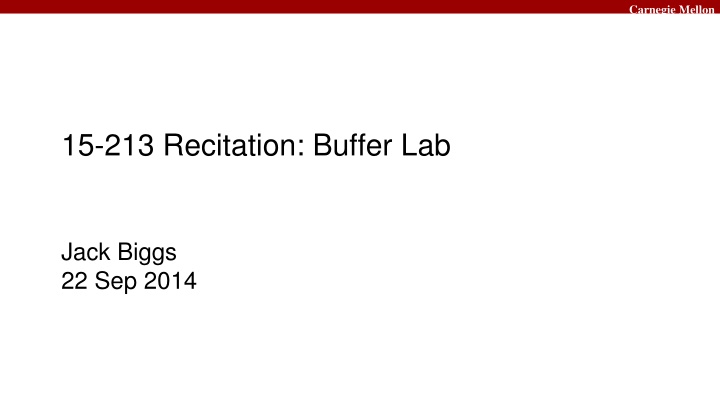
Stack Frames and Function Calls in IA32 Architecture
Explore the intricacies of stack frames and function calls in the IA32 architecture at Carnegie Mellon through detailed explanations and informative visuals. Learn about register conventions, stack growth, and the setup and return processes for function calls.
Download Presentation

Please find below an Image/Link to download the presentation.
The content on the website is provided AS IS for your information and personal use only. It may not be sold, licensed, or shared on other websites without obtaining consent from the author. If you encounter any issues during the download, it is possible that the publisher has removed the file from their server.
You are allowed to download the files provided on this website for personal or commercial use, subject to the condition that they are used lawfully. All files are the property of their respective owners.
The content on the website is provided AS IS for your information and personal use only. It may not be sold, licensed, or shared on other websites without obtaining consent from the author.
E N D
Presentation Transcript
Carnegie Mellon 15-213 Recitation: Buffer Lab Jack Biggs 22 Sep 2014
Carnegie Mellon Reminder Bomb lab is due tomorrow! Buffer lab is released tomorrow!!
Carnegie Mellon IA32: Register Conventions Arguments not saved in registers (passed on stack) Return value: %eax Callee-saved: %eax, %ecx, %edx Caller-saved: %edx, %edi, %esi Base pointer: %ebp Stack pointer: %esp Instruction pointer: %eip Register? I barely knew er!
Carnegie Mellon IA32: The Stack Grows downward towards lower memory addresses %esp points to top of stack Bottom 0xffffffff push %reg: subtract size from %esp, put val in %reg at (%esp) pop %reg: put val at (%esp) in %reg, add size to %esp %esp Top
Carnegie Mellon IA32: Stack Frames Every function call has its own stack frame. Think of a frame as a workspace for each call. Local variables (arrays, structs, scalars) Callee & Caller-saved registers Preparing arguments for a function call Old %ebp Saved registers Caller frame Local variables Arguments Return addr (%ebp) Old %ebp Saved registers Callee frame Local variables (%esp)
Carnegie Mellon IA32: Function Call Setup Push any caller-saved registers that are in use Push arguments to stack (in reverse order) call foo: push %eip to stack, jump to label foo Callee: push %ebp; mov %esp, %ebp; decrease %esp to make room for new frame
Carnegie Mellon IA32: Function Call Return At end of function, execute leave followed by ret leave: movl %ebp, %esp; popl %ebp ret: popl %eip
Carnegie Mellon Convention Example int main() { int x = 3; int y = 5; foo(x, y); return 0; } int foo(int x, int y) { return x + y; }
Carnegie Mellon x86_64 No frame pointers! %ebp is free! Arguments passed in registers! More use of registers in general! Less of stack, because the stack sucks! Harder to exploit than IA32. Consider yourselves lucky.
Carnegie Mellon Buffer Lab Overview Exploit IA32 by overwriting the stack Overflow a buffer, overwrite return address Brush up on your IA32 conventions! Find out how length of input, what string, etc Use gdb!!!!!!!
Carnegie Mellon Buffer Lab Tips Stack Canaries are special values on the stack Detect overrun of buffer if changed Placed immediately after a buffer nop sleds nop does nothing (no operation) Pad instructions if stack addresses randomize
Carnegie Mellon Buffer Lab Tools ./makecookie <andrewid> Make your cookie appear where it shouldn t ./hex2raw Pass raw ASCII strings to bufbomb ./bufbomb -t <andrewid> Your bomb! Don t worry, it won t explode and cost you points. gcc -m32 <file.c> Compile exploit code (later on)
Carnegie Mellon Also...
Carnegie Mellon Demonstration!
